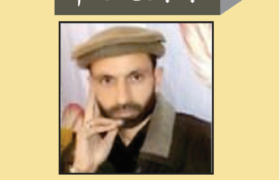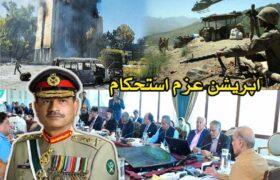From Guns to Roses the story of Erstwhile FATA (II)
By Kashmala Yousafzai
911 had changed the world after the US and allied attacked Afghanistan, the number of Afghan refugees increased as well as extremism in these areas. Incidents of terrorism also increased. US drone strikes have increased hatred against the United States. Since 1977, however, governments have begun planning for reforms in the FATA region, and some steps were taken slowly but with 9/11 and allied troops, the presence of large numbers of NATO forces, and Pakistan’s becoming a non-NATO ally, the administrative structure of the region began to change.
In 1976, a committee headed by Naseerullah Khan Babar was formed for FATA reforms. Its members included important personalities like Hafeez Pirzada, Rafi Raza and Dr. Mubashir Hassan. The main purpose of this committee was to make these areas part of the NWFP. In 1996 right to vote for adults enacted and for the first time, the people of the tribal areas exercised their right to vote in the 1997 elections.
The first decade of the 21st century can be described as the decade of change in the tribal areas. In April 2005, a committee headed by Justice (retd) Mian Muhammad Ajmal was formed to reform the Frontier Crimes Regulation. Lawyers, in consultation with the country’s legal experts, recommended a number of reforms to the FCR, but these could not be implemented. In 2006, a task force headed by Sahibzada Imtiaz Ahmed again prepared a report on FATA’s administrative affairs which was presented in a meeting chaired by President General Pervez Musharraf. It includes the establishment of a FATA Secretariat, the FATA Development Authority, the traditions of the tribal areas, the preservation of customs and traditions, the removal of ambiguity in the rules and regulations of the federal, provincial, administered tribal areas, the tribal rituals for maintaining law and order. In addition, most importantly, a high-powered commission was to be set up to plan for the future of the tribal areas, with state-of-the-art facilities, and to maintain their traditions.
In 2008, Governor Owais Ahmad Ghani assigned a Cabinet Reform Committee to implement the FCR Reform Report. The committee adopted far-reaching recommendations, including replacing the Frontier Crimes Regulation with the FATA Regulation 2008. The appointment of a District and Sessions Judge to hear appeals against the decision of political agents was a very important suggestion. A FATA tribunal headed by a retired High Court judge. These recommendations were welcomed.
Khyber Pakhtunkhwa was unanimously approved as the name of the North-West Frontier Province during (2008-2013), thus the long-standing demand of the people of the region that the province should have a regular name was fulfilled. At the same time, efforts were made for the regular integration of FATA into Khyber Pakhtunkhwa. A five-member FATA Reforms Commission was set up in May 2014. The commission submitted its report to the Governor of Khyber Pakhtunkhwa in April 2015. In 2016, the recommendations on FATA issues reached a turning point.
FATA Reforms Committee headed by Sartaj Aziz recommended FATA to be mainstream. After 9 months of consultations and discussions, it was decided that the areas of FATA would be integrated into Khyber Pakhtunkhwa. People here will vote for provincial assembly seats. Areas of FATA will come under the jurisdiction of the Supreme Court and the High Court.
A high-powered committee was set up in these areas for social, political and economic planning for the next ten years. On May 24, 2018, the National Assembly approved the integration of FATA into Khyber Pakhtunkhwa through a constitutional amendment. The PML-N, Pakistan People’s Party, Pakistan Tehreek-e-Insaf, Jamaat-e-Islami and Muttahida Qaumi Movement voted in favour of the amendment. While Jamiat Ulema-e-Islam (Fazal Group) and Pakhtunkhwa Milli Awami Party walked out. The Senate also approved it.
May 24, 2018 on the demand of the tribal people FATA bevcamea regular part of the state of Pakistan and Khyber Pakhtunkhwa.
This journey of more than a century witnessed the people of FATA voting enthusiastically for the Provincial Assembly in July 2019. The people of Pakistan welcomed the brave, zealous brothers of erstwhile FATA as mainstream participants. That bright morning rises on August 28, 2019, when 19 elected representatives from the formerly merged districts took oath under the Constitution of Pakistan in the Khyber Pakhtunkhwa Assembly.
KP Assembly Speaker Mushtaq Ghani warmly congratulated the newly elected members and said that today we are embarking on a new journey and the 5 million people of the merged districts have high expectations from their representatives. This is a historic day for the KP Assembly and for all the political parties and personalities who have struggled for years to bring the tribal areas into the mainstream.

The integration of erstwhile FATA districts into Khyber Pakhtunkhwa brought the vast area into mainstream. The promises made by the founder of Pakistan, Quaid-e-Azam Muhammad Ali Jinnah, to tribal dignitaries on April 17, 1948 at Government House Peshawar was fulfilled.
The people of FATA have suffered a lot from foreign extremists to attacks from Afghanistan to drone attacks. Their homes were destroyed, crops were destroyed, businesses were affected, so they now deserve a stable and bright future. The Government of KP, the Government of Pakistan, the Industrial and Commercial Institutions of Pakistan are ready to practically harness social, political, industrial, economic and educational development of the people living in these districts.
Constant efforts will be required to make these compatriots aware of the new rules and regulations.
The Planning and Development Department of the Khyber Pakhtunkhwa government has prepared 10-year development programme (2020-2030). The various stages and plans of this programme include 10-Year Strategy and Implementation, Historically Ignored Development Issues, Development Priorities in Integrated Areas, Technical, Preparation of Consultative Projects, Fulfillment of Ambitions, and Accountability Institutions, Governance and Protection of Rights, Formation of Municipal Institutions And local government, training of officers for services, human resource welfare, education, public health, drinking water and sanitation, Social welfare and protection of social values, women’s rights, youth, sports and culture, expansion of economic infrastructure, highways, bridges, roads, rural electricity supply, distribution, irrigation, agriculture, livestock, dairy farming, fisheries , Industries and Companies, Skills Training, Employment Opportunities, Sustainable Resource Management, Forests, Environment and Wildlife, Minerals, Mines, Oil and Gas.
Development by Pakistan Army in FATA: Harbinger of FATA-Merger
The Challenge of introducing far-reaching reforms was multi-pronged and complex and this was witnessed during the initial phase of the build-up phase kick-started by the Pakistan Army after clearance of troubled areas in FATA. The presence of the Pakistan Army is crucial as local administrative units are taking over the responsibility of governance. The current role of the Pakistan Army is to hold and build. Under this role, Pakistan Army, over the last couple of years of relative calm, has completed many socio-economic projects including infrastructure building in this war-torn region.
These development projects include hospitals, schools, colleges, market places, and roads. Many of these have been transferred to the local civilian authorities. But before this role, the Pakistan army was fought and won a ruthless bloody war within its border. The military aspect of this complex hybrid war against Pakistan has been won but there are other subtle axes where the enemy is still trying to undermine the achievements in FATA.
Pakistan Army has carried out massive development work during the years of war in this region as well. This development work was unique and the most valuable because it was this work that makes local tribes see the value of development and infrastructure first hand. Below is a brief look at the development work carried out by Pakistan Army which ushered in FATA reforms eventually.

Education
Cadet College, Wana, South Waziristan
Cadet College, Razmak, North Waziristan
Cadet College Momad Gat, Mohmand
Education Complex Ghalijo, Orakzai
FC Public School for Girls Wana, South Waziristan
Fatima Jinnah Girls Hostel, Khar, Bajur
Khar Public School and College, Khar, Bajur
FC Public School, Wana, South Waziristan
Mohmand Model School, Mohmand
Women Vocational Training Centre, Wana, South Waziristan
Women Vocational Training Centre, Khar, Bajur
Golden Arrow Pakistan Sweet Home, Mir Ali, North Waziristan
Health & Recreation
Khar Hospital, Bajur
Sheikha Fatima Binte Mubarak Hospital, Wana, South Waziristan
Limb Centre, South Waziristan
Younas Khan Sports Complex, South Waziristan
Football Stadium, North Waziristan

Road, Energy & Transportation
Nahqi Tunnel, Mohmand KP
Dogar- Samma Road, Kurram KP
Gomal Zam Dam , South Waziristan

Business
Pakistan Market, South Waziristan
Town Bazar, Razmak
Apple Farms, South Waziristan
Agri Park Wana, South Waziristan
Model Marker Miranshah, North Waziristan
Pine Nut Process plant, South Waziristan
Muhammed Khel Copper Mining Project, North Waziristan
Marble Industry, Mamat Gat, Mohmand
Border Management

Angor-Adda border terminal, South Waziristan Agency
Ghulam Khan border terminal, North Waziristan Agency
FATA reforms are a historical step towards socio-economic development and security of the state. These historic reforms will mainstream our tribal people after seven long decades and will integrate this war-torn region with mainland Pakistan. These reforms promise long term development work in tribal districts. Pakistan’s army has been the key player responsible for this social transformation of locals through which they were able to see the value of the development




